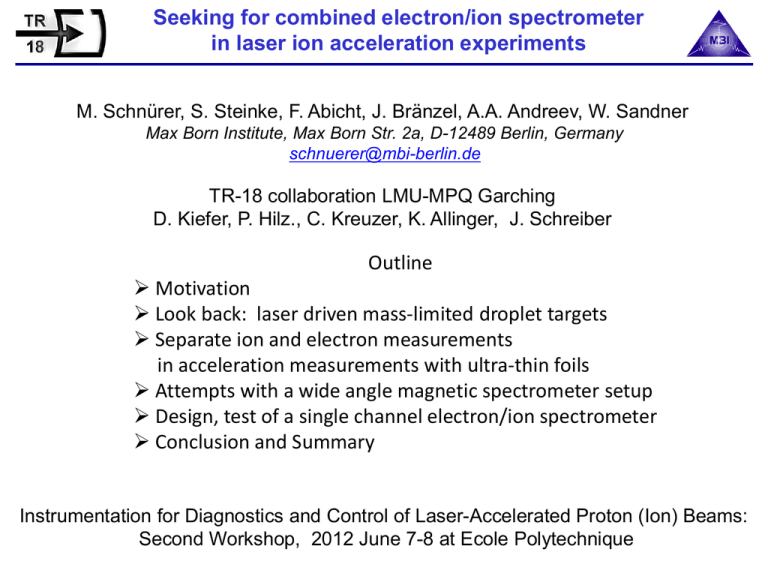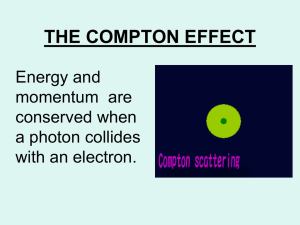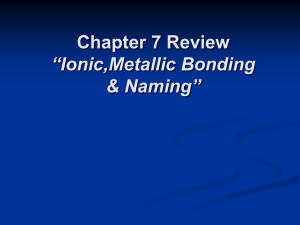LULI_Iondiagnostic2012_mschnue_1
advertisement

Seeking for combined electron/ion spectrometer in laser ion acceleration experiments M. Schnürer, S. Steinke, F. Abicht, J. Bränzel, A.A. Andreev, W. Sandner Max Born Institute, Max Born Str. 2a, D-12489 Berlin, Germany schnuerer@mbi-berlin.de TR-18 collaboration LMU-MPQ Garching D. Kiefer, P. Hilz., C. Kreuzer, K. Allinger, J. Schreiber Outline Motivation Look back: laser driven mass-limited droplet targets Separate ion and electron measurements in acceleration measurements with ultra-thin foils Attempts with a wide angle magnetic spectrometer setup Design, test of a single channel electron/ion spectrometer Conclusion and Summary Instrumentation for Diagnostics and Control of Laser-Accelerated Proton (Ion) Beams: Second Workshop, 2012 June 7-8 at Ecole Polytechnique Motivation: Investigation of acceleration potential and electron energy distribution in the TNSA-regime TNSA scheme precursor electrons which leave the target and built up the potential wall their energy distribution gives information about: - ponderomotive potential of laser field (and thus acting laser intensity) or additional electron acceleration mechanism - acceleration potential (wall) in electron – ion sheath Motivation: Acceleration potential and electron energies in the RPA-regime displaced electrons due to pressure impact (laser accelerates electrons) balance IL c ~ oE Laser 2 s restoring (electrostatic) force due to ion background e0 E relativistically a0 normalized m ec L laser vector potential balance condition 2 IL a0 L a0 ~ 1 . 37 10 18 W m cm ne d nc L 2 2 2 critical 0 m e L electron n c 2 e0 density normalized areal electron density Motivation: optimum ion acceleration in the RPA-regime and beyond – electron blow out different cases for laser intensity IL in relation to target thickness d :c a0 ~ optimum ion acceleration a0 > electron blow out Motivation: investigation of electron blow out – perspective of flying electron mirror 2D PIC simulations (A.A. Andreev) Laser parameters : I 5 10 19 W / cm 2 t L 45 fs d L 6 m C-target parmeters : l f 0.6 nm n i 6 10 cm 22 3 Electron density distribution function at t=17 fs Circular polarization 33fs electron mirror moves with 0,92 c0 with g ~ 2.55 possible frequency up shift of reflected light by a factor 4 g2 ~ 26 electron signal on film (arb.u.) Look back: laser driven mass-limited droplet targets simple electron spectrometer with dosimetric film 1 scanned film data (relative absorption) smoothed 0.1 Electron confinement in the spherical plasma is visible in the emitted electron spectrum from a single droplet. 1x10 charged particle burst exponential slope: exp(-E/kTe-hot) with kTe-hot ~ 600 keV 6 ponderomotive potential at 1019 W/cm2 ~ 640 keV 2x10 6 3x10 6 energy (eV) B = 0.27 T electrons GAF-chromic HD810-film ~ integration of 104 pulses S. Busch et al., APL (2003) Look back: laser driven mass-limited droplet targets imaging MCP for electron detection Laser ~ 2 mm aperture at about 35 cm distance B-, Efields imaging MCP for ion detection advantage: - single pulse, online detection disadvantage: - small detection range for electron energies - large aperture to achieve reasonable electron signal gave low resolution Look back: laser driven mass-limited droplet targets cutoff deuteron energy (keV) Dependance of ion cutoff energies on maximum observed electron energies in correlated detection indicate a sensitive influence of energetic electrons on ion acceleration. 800 600 400 200 1400 1500 1600 1700 maximum electron energy (keV) S. Ter-Avetisyan et al., PRL 2004 Separate ion and electron measurements in acceleration measurements with ultra-thin foils design (D.Kiefer MPQ) of a magnet spectrometer for electrons suitable for a range 1 MeV … 10 MeV LANEX screen approx. 25 cm long ~ 2 mm aperture at about 40 cm distance from source advantages - reasonable energy resolution - single pulse, low - but detectable signals - calibration data of fluorescent screen material available disadvantages - fringe fields of magnet introduce beam focusing and defocusing ( try with stronger magnet and electron MCP-detection failed) - setup hardly combinable with 80 mm MCP for ion detection for reasonable energy range and resolution Separate ion and electron measurements in acceleration measurements with ultra-thin foils A glimpse of the experiment Separate ion and electron measurements in acceleration measurements with ultra-thin foils to achieve of electron blow out red glowing 3nm DLC transition from optimum ion acceleration to electron blow out Prad 2 I / c Pes ( en 0 D ) / 2 2 proton cutoff energy (MeV) 22 10 2 intensity (W/cm ) 21 10 protons 12 10 DLC Al Ti 8 6 4 2 0 1 10 100 1000 foil thickness (nm) 20 10 19 10 electrons 18 10 0 5 10 15 20 target thickness (nm) 25 D. Kiefer, et al., in preparation D 3 nm 14 500 µm Attempts with a wide angle multi-pinhole magnetic spectrometer setup ion phase space angle 2° 0° -2° energy angle detection limit electron phase space 5° advantage 0° - correlated ion and electron detection with angular emission (phase space) information disadvantage -20° - strong inhomogeneous B-field requires extensive 3D-tracking and numerical data analysis - no E-field for ion TP, blurring and background, requires MCP gating S. Ter-Avetisyan et al. POP 16, 043108 (2009), D. Jung et al. RSI 82, 043301 (2011) energy Angular resolved electron emission from laser (3x1019W/cm2 @ 40 fs) irradiated 100 nm CH-foil principle potential of the spectrometer is clearly visible a more homogeneous 3D B-field geometry should be possible which provides better manageable data evaluation B-field along spectrometer axis of used setup data evaluation in progress D. Kiefer MPQ electron energies 0.5 1 2 5 MeV Design, test of a single channel electron/ion spectrometer design goals: - to avoid influence of fringe fields and large inhomogeneous fields - reasonable resolution detected electron signal level is low: 0.4 mm pinhole at 80 cm source distance 1 4 7 10 31 MeV 10 2 1 0.1 T + E- field MeV scintillator screen inside B-field test experiments with 5 micron Ti - foil proton , C4+ trace Summary and Conclusion several experiments in laser ion acceleration showed the usefulness of correlated electron/ion data to explore acceleration mechanisms upcoming experiments to access the flying electron mirror regime underline the need of combined electron spectrometer the limited electron flux from laser driven thin foils forces spectrometer solutions with relative small distances between source and entrance aperture + dispersion unit while keeping a reasonable resolution for both electrons and ions and taking size restrictions as well as thresholds of imaging detectors into account separated slit apertures and separated B- , E- fields, specific field configurations, MCP-gating and/or other electron, ion detectors (semiconductor based) offer further and interesting design possibilities Credits A.A. Andreev (also VSI St. Petersburg), F. Abicht, J. Bränzel, W. Sandner T. Sokollik (presently LBNL), S. Steinke (presently LBNL), T. Paasch-Colberg (now MPQ), P.V. Nickles (GIST Korea), Laser+HFL: L. Ehrentraut, G. Priebe, M.P. Kalashnikov, G. Kommol (MBI) Transregio 18 collaboration: MPQ / LMU Munic: J. Schreiber, D. Kiefer , P. Hilz, K. Allinger, C. Kreuzer T. Tajima, J. Meyer-ter-Vehn, D. Habs, A. Henig, R. Hörlein, X. Q. Yan, D. Jung, M. Hegelich (LANL) HHU Düsseldorf, FSU Jena S. Ter-Avetisyan (MBI, QUB, now ELI – beam lines Prague ) High Field Laser Laboratory at Max-Born-Institute Thank you for your attention !









